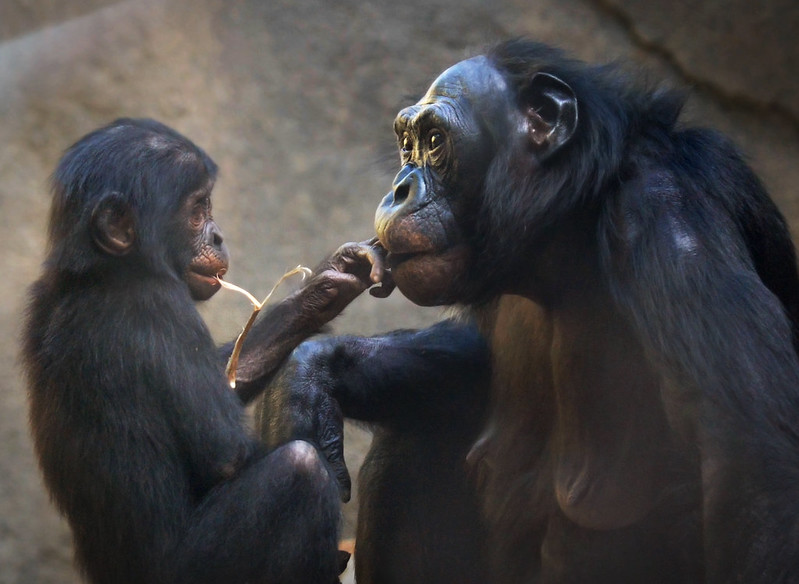When discussing our closest evolutionary cousins, most people immediately think of chimpanzees (Pan troglodytes). Rightly so—they share approximately 98.7% of their DNA with humans. But what often surprises people is that bonobos (Pan paniscus), another species in the Pan genus, are just as closely related to us as chimpanzees are. While the two species look similar at first glance, they differ profoundly in behavior, social structures, emotional expression, and possibly even cognition. These differences reflect not just separate physical evolutions but diverging emotional and psychological pathways. The evolutionary implications are fascinating and may hold vital clues to understanding our own species.
Divergent Environments, Divergent Evolution
Chimpanzees and bonobos diverged from a common ancestor approximately one to two million years ago. This split likely occurred due to the formation of the Congo River, which physically separated populations. To the north of the river, chimpanzees evolved in environments that were often more competitive, resource-scarce, and threatening, necessitating a more aggressive and hierarchical social structure. To the south, bonobos evolved in relatively resource-rich forests with fewer natural predators, which allowed for different social dynamics to flourish.
This environmental divergence created the conditions under which each species developed unique behavioral strategies. Over time, these strategies have shaped not just how they interact with one another but how they think, feel, and resolve conflict—key aspects of what might be considered their emotional and cognitive worlds.
Social Structures: Hierarchy vs. Harmony
Chimpanzee Society: Dominance and Competition
Chimpanzee society is patriarchal and highly hierarchical. Males compete aggressively for dominance, and alliances often determine social standing. Physical strength and the ability to form political coalitions play critical roles in establishing leadership. Violence is not uncommon. Infanticide, territorial warfare, and status-driven aggression occur regularly among chimpanzees.
In this competitive environment, emotions like jealousy, anger, and fear have evolutionary utility. A chimpanzee’s ability to navigate alliances, detect deception, and intimidate rivals often determines its survival and reproductive success. As such, their social and emotional lives are tuned to deal with a world that rewards strategic aggression and vigilance.
Bonobo Society: Peace and Pleasure
In contrast, bonobo society is matriarchal and strikingly egalitarian. Females hold considerable power and often form strong coalitions that can challenge and even overpower male aggression. Bonobos are also famous for using sexual behaviors—not just for reproduction but as tools for conflict resolution, social bonding, and even play. This sociosexual behavior contributes to a remarkably peaceful society with much lower levels of aggression than seen in chimpanzees.
Bonobos show high degrees of empathy, consolation behaviors, and cooperative interactions. They exhibit emotions in ways that seem remarkably human—comforting one another after conflict, showing sensitivity to social exclusion, and engaging in face-to-face eye contact. Their emotional repertoire appears geared toward maintaining group cohesion and reducing conflict, which suits their less threatening environment.
Emotional Evolution: Different Brains, Different Feelings?
The differences in bonobo and chimpanzee behavior are not just cultural; they are underpinned by differences in neurochemistry and brain anatomy.
Brain Structure and Neurochemistry
Studies have found that bonobos have higher densities of certain brain cells involved in empathy and emotional regulation. For instance, the anterior cingulate cortex—a region associated with emotion, empathy, and social cognition—is more developed in bonobos than in chimpanzees. Bonobos also show higher levels of oxytocin (the “bonding hormone”) during social interactions, and they engage in more frequent grooming and affiliative behaviors.
Conversely, chimpanzees have more developed amygdala structures, which are associated with fear, aggression, and emotional arousal. These neurological differences likely reflect adaptations to their respective environments and social systems. In chimpanzees, higher arousal and sensitivity to threat would be advantageous in a competitive, hierarchical society. In bonobos, calming mechanisms and social bonding would be more beneficial in a peaceful, cooperative group.
Anxiety and Social Stress
One of the most fascinating questions is whether one species is more prone to anxiety. While hard to measure directly, behavioral studies suggest that chimpanzees experience higher levels of social stress. Dominance struggles, shifting alliances, and the constant threat of violence can lead to psychological distress. Subordinate males and females often show submissive behaviors and heightened cortisol levels—indicators of chronic stress.
Bonobos, by contrast, appear to have more stable social relationships and lower baseline cortisol levels. Their social strategies, including sociosexual behaviors, seem to function as stress-reduction tools. This doesn't mean bonobos are immune to anxiety, but their emotional toolkit is better adapted for preventing or mitigating social tension.
Cognition and Mental Evolution
Problem-Solving and Tool Use
Chimpanzees have been observed using tools extensively in the wild—fishing for termites with sticks, cracking nuts with stones, and even using spears for hunting. These behaviors require foresight, planning, and imitation, and they demonstrate considerable cognitive sophistication. Chimpanzees also show strong performance on memory and problem-solving tasks.
Bonobos also use tools, but less frequently and with less complexity in the wild. However, in laboratory settings, bonobos often outperform chimpanzees on social cognition tasks, such as understanding others’ intentions, cooperating for mutual gain, and interpreting social cues. They seem more adept at tasks that require empathy, patience, and perspective-taking.
Cognitive Styles and Evolutionary Strategies
These findings suggest that chimpanzees and bonobos may represent different "cognitive styles" evolved for different challenges. Chimpanzees are optimized for tasks requiring physical manipulation, strategic aggression, and tactical planning. Bonobos, in contrast, appear tuned for social understanding, emotional regulation, and peaceful cooperation.
Neither is “smarter” in a general sense. Instead, their mental capacities are shaped by different evolutionary pressures: chimpanzees by competition and resource defense, bonobos by social cohesion and conflict avoidance.
Human Parallels: More Chimp or Bonobo?
This brings us to a profound question: Are humans more like chimpanzees or bonobos?
The Dual Legacy Hypothesis
Most researchers agree that humans share traits with both species. Like chimpanzees, humans can be aggressive, hierarchical, and capable of extraordinary violence. Human history is filled with warfare, conquest, and competition for status. Yet, like bonobos, we are capable of deep empathy, long-term cooperation, and profound social bonding. We comfort the distressed, form complex friendships, and build communities based on shared norms and values.
Some scientists refer to this as the “dual legacy” of human evolution. Our ancestral line inherited both the competitive, dominance-oriented behaviors of chimpanzees and the affiliative, cooperative tendencies of bonobos. Our emotional range and cognitive flexibility likely evolved from the need to balance these sometimes conflicting impulses.
Social Institutions as a Mirror
Interestingly, human societies tend to reflect this tension. Some cultures or subcultures lean more toward hierarchical, competitive models of social organization, while others emphasize egalitarianism and empathy. Institutions like democracy, education, and social welfare can be seen as attempts to elevate our bonobo-like tendencies, while warfare, inequality, and dominance politics reflect our inner chimpanzee.
Our species has the unique capacity for metacognition—the ability to reflect on our own thoughts and behaviors—which allows us to choose which aspects of our evolutionary inheritance to nurture. This makes the study of our primate cousins not just a matter of scientific curiosity, but of deep moral relevance.
Evolutionary Fitness: Two Paths to Survival
Both chimpanzees and bonobos are successful species in evolutionary terms. Each has adapted to its specific ecological niche and developed behavioral strategies that support survival and reproduction.
Chimpanzees: Fitness Through Dominance and Strategy
For chimpanzees, reproductive success is often linked to dominance. High-ranking males have greater access to fertile females and can pass on their genes more effectively. This creates selective pressure for aggression, alliance-building, and strategic behavior.
Bonobos: Fitness Through Affiliation and Cooperation
In bonobo society, female alliances play a critical role in social stability. Female bonobos prefer to mate with males who are sociable, playful, and less aggressive. This creates selective pressure for gentleness, emotional intelligence, and affiliative behaviors. In a sense, "nice guys" do finish first—at least in bonobo society.
These two reproductive strategies highlight that evolutionary fitness is context-dependent. Traits that are advantageous in one environment may be maladaptive in another. The success of each species demonstrates the flexibility of evolutionary pathways in response to different social and ecological pressures.
Conclusion: A Mirror for Ourselves
The differences between bonobos and chimpanzees reveal the incredible plasticity of emotional and cognitive evolution. From aggression to empathy, from dominance hierarchies to egalitarian coalitions, our primate relatives embody the spectrum of behaviors we ourselves exhibit. Understanding their emotional worlds helps illuminate our own nature—not as fixed or predetermined, but as a set of tendencies shaped by environment, culture, and choice.
In the end, perhaps the most important lesson from bonobos and chimpanzees is not which species we are more like, but which parts of ourselves we choose to cultivate. As the only species with the cognitive capacity to shape our future consciously, we bear the responsibility of deciding whether to lean into our chimpanzee aggression or our bonobo compassion.
Further Reading:
• Our Inner Ape by Frans de Waal
• The Bonobo and the Atheist by Frans de Waal
• The Age of Empathy by Frans de Waal
• Demonic Males: Apes and the Origins of Human Violence by Richard Wrangham and Dale Peterson
• The Goodness Paradox by Richard Wrangham
• Behave by Robert Sapolsky
These works delve deeply into ethology, primate behavior, and the evolutionary roots of human emotions and morality. Each contributes uniquely to our understanding of how chimpanzees and bonobos reflect parts of the human condition.
Picture: Fueling Creative Fires
|
|






